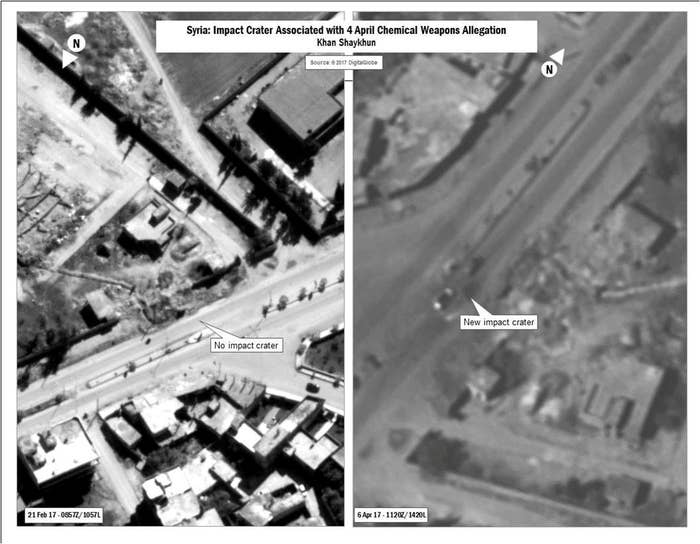
WASHINGTON — US officials said on Tuesday the evidence that Syrian President Bashar al-Assad used the nerve agent sarin in an attack last week is overwhelming and accused the Russian government of waging a “disinformation" campaign to shield the Syrian government from criticism.
The White House comments were part of a full-court press by the US government to explain the reasons for its Apr. 6 strike, stressing that the strikes were not part of larger US intervention in Syria and demanding more from Russia, all ahead of Secretary of State Rex Tillerson’s scheduled meetings on Wednesday in Moscow with his Russian counterpart.
The remarks came ahead of the White House’s declassification of a four-page report accusing Syria and Russia of spreading “false narratives” about the attack that killed about 80 people and prompted a US military strike.
"The Syrian regime and its primary backer, Russia, have sought to confuse the world community about who is responsible for using chemical weapons against the Syrian people in this and earlier attacks," said the National Security Council report.
Officials said a wealth of evidence supported their claim, citing open-source videos, satellite imagery, intercepted communications, and physiological evidence from the attack site. By releasing the report, the Trump administration showed a growing willingness to confront Moscow and rebut its claims on the world stage.
The White House stopped short of accusing the Russian government of knowing in advance that Syria planned to wage the attack, but one official said Moscow’s close military cooperation with Syria was clearly troubling.

Defense officials on Friday also declined to make that claim when speaking with BuzzFeed News, but noted a Russian drone appeared to have been deployed near a hospital that treated the chemical attack’s victims and shut off its camera right before the hospital itself was bombed.
In explaining the Syrian government’s rationale for waging the attack, an official said the regime’s resources were “spread quite thin” and that it probably deployed sarin gas to “make up for the manpower deficiency.” The officials did not make clear precisely when the US came to this conclusion about the Assad regime’s motives.
Defense Secretary Jim Mattis, appearing on Tuesday at his first Pentagon press briefing since taking office, stressed that the strike was an isolated incident, not the beginning of ramped up US intervention.
“This was a separate issue that arose in the midst of [anti-ISIS] campaign,” Mattis said, adding: “There is a limit, I think, to what we can do, and when you look at what happened with [the April 4] chemical attack, we knew that we could not stand passive on this. But it was not a statement that we could enter full-fledge, full fore into the most complex civil war probably raging on the planet at this time.”
And yet Mattis kept the door open to further US strikes against the Syrian regime if it used nerve agents again against the its people. Mattis said it was up to Syria to honor the 1925 Geneva protocol and the 2013 agreement between Syria and the international community, in which Damascus agreed to turn over all of its chemical weapons for destruction.
Despite that agreement four years ago, Mattis said he had “no doubt” that the Assad regime, planned, orchestrated and executed the April 4 attack.
Officials said it was important to bring this message to the United Nations and the Organization for the Prohibition of Chemical Weapons (OPCW) in order to deter the Assad regime from carrying out similar attacks.
"This is a critical moment — we must demonstrate that subterfuge and false facts hold no weight, that excuses by those shielding their allies are making the world a more dangerous place,” the report stated.
The report did not describe specific consequences for another chemical attack but said the use of such chemicals is “unacceptable.”
Moscow and Damascus have offered a range of alternative accounts surrounding the attack, including that “terrorists” controlled a depot of chemical weapons that was targeted in the attack. They have also dismissed U.S. and Western accounts claiming that the footage shown was taken from fake or old videos. The US officials explicitly ruled out any possibility that terrorists or rebel forces possessed the type of chemical weapons use in the attack.
The report follows remarks by Tillerson on Tuesday that the reign of Assad “is coming to an end.” At the same time, the secretary said the US was seeking a negotiated end to the six year civil war in Syria rather than a military campaign aimed at regime change.

